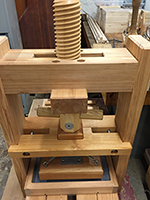In this section, Professor Jeffrey Ravel describes the inspiration for developing 21H.343J / CC.120J Making Books: The Renaissance and Today. He also shares community resources he and his co-instructors used to learn more about presses and handset printing prior to teaching the course, advice to other educators developing similar courses, and his vision for future course iterations.

The printing press built by students in the MIT Hobby Shop.
Inspiration
Prior to teaching 21H.343J / CC.120J Making Books: The Renaissance and Today I taught courses on book history. In these courses, we visited Harvard University to letterpress print on their Bow and Arrow press. The Bow and Arrow press is a wonderful resource, but I wanted MIT students to be able to handset print here on campus. I figured we would be able to build a press together—and that is what inspired the development of 21H.343J / CC.120J Making Books: The Renaissance and Today, a hands-on course in which students explore key historical readings, engage with rare print objects, build their own printing press—and make their own cotton rag paper for use with the press.
Preparation
The biggest challenge was the improvisational nature of the class: because we weren’t sure how long it would take to build the press, we had to be flexible when planning the other parts of the course, such as the discussions of assigned readings and students’ interactions with the archival materials.
— Jeffrey Ravel
To prepare for the course, my co-instructors, Professor Anne McCants and Hobby Shop Director Ken Stone, and I, made several field trips to learn more about presses and handset printing. We visited the Book Arts Program at Wellesley College, the Printing Office of Edes & Gill in Boston, the Firefly Letterpress in Brookline, where the owner runs monotype and linotype machines, the American Antiquarian Society in Worcester, which houses the Thomas Press from the 18th Century, and Letterpress Things, a printing supply store in Chicopee, Massachusetts.
We also visited the Rare Books Collections of the MIT Libraries and the MIT Museum to get a sense of the archival materials we’d be able to share with students. Concurrently, we began developing our syllabus and creating a realistic plan for building the printing press and printing during the course of the term. The biggest challenge was the improvisational nature of the class: because we weren’t sure how long it would take to build the press, we had to be flexible when planning the other parts of the course, such as the discussions of assigned readings and students’ interactions with the archival materials.
Advice
The experience of teaching 21H.343J / CC.120J Making Books: The Renaissance and Today, with its multiple components, reinforced something I already knew: with enough advanced planning, MIT students are capable of doing remarkable things over the course of a semester. We found a good balance between classroom discussion, examination of books between 300 and 500 years old, and the building process. My advice to other instructors planning similar courses is as follows: do lots of planning before the course starts; have your syllabus in order, and if you’re building something, have your finances and material sources in place before the term starts.
Iteration
Now that we have a working printing press, we would like students to spend more time actually printing the next time we teach the course. In particular, we’d like to write, typeset, and print a multi-page pamphlet on a historical theme that we will jointly choose with the students. We also want to continue to perfect our paper-making technique so that we will ultimately be printing all our work on paper we have made ourselves. We’d also love to design and cast our own type, but that is probably something we’ll tackle at some point in the future.
